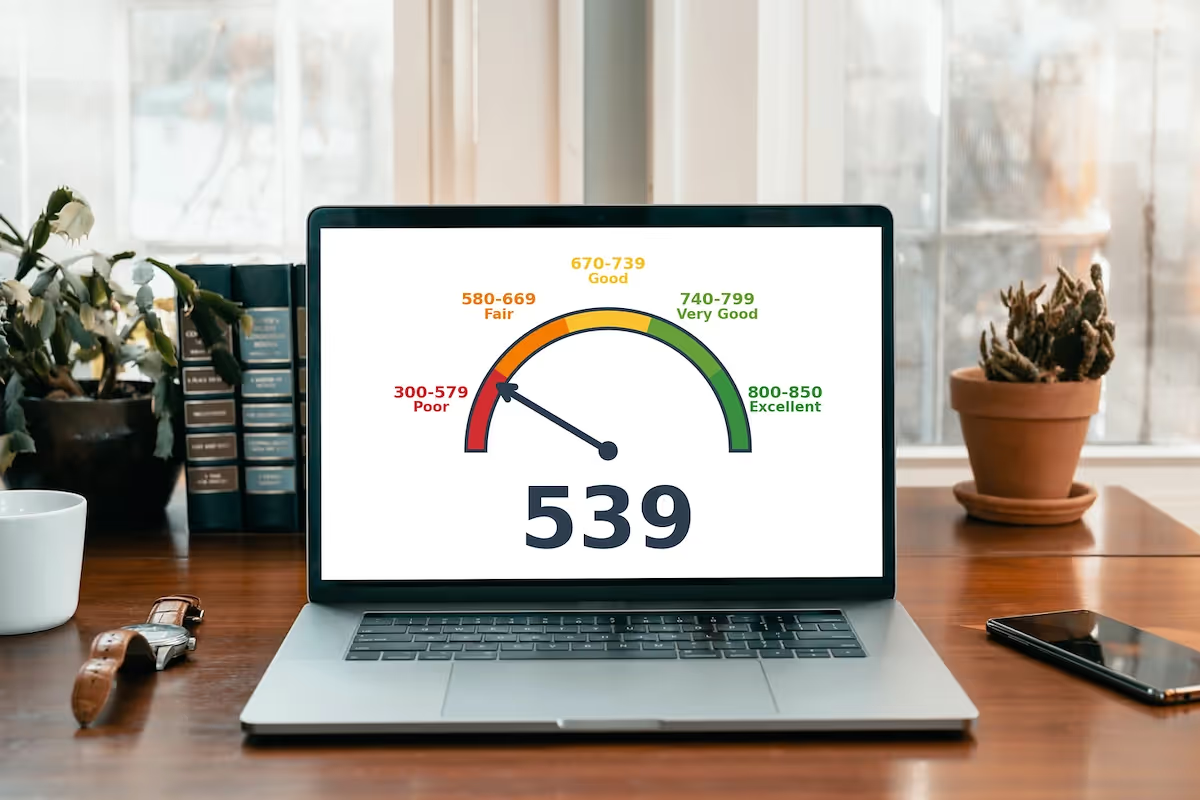
Kudos has partnered with CardRatings and Red Ventures for our coverage of credit card products. Kudos, CardRatings, and Red Ventures may receive a commission from card issuers. Kudos may receive commission from card issuers. Some of the card offers that appear on Kudos are from advertisers and may impact how and where card products appear on the site. Kudos tries to include as many card companies and offers as we are aware of, including offers from issuers that don't pay us, but we may not cover all card companies or all available card offers. You don't have to use our links, but we're grateful when you do!
539 Credit score: What You Need to Know in 2025
July 1, 2025


TL;DR
A 539 credit score offers a clear opportunity for growth and is a foundation you can certainly build upon. This score falls into the "Poor" range on the FICO scale, which highlights a prime opportunity to improve your creditworthiness and financial standing.
What Does a 539 Credit Score Mean?
A 539 credit score falls into the 'Poor' category on the FICO scale, which ranges from 300 to 850. Lenders view scores in this range as a sign of high risk, often indicating a history of credit management challenges. This number signals to potential creditors that you may have had difficulty meeting debt obligations in the past, making them cautious about extending new credit.
This score will likely impact your finances by making it difficult to get approved for new loans or credit cards. If you are approved, you can expect high interest rates, which makes borrowing significantly more expensive. While this presents immediate challenges, a credit score is not permanent. Understanding its impact is the crucial first step toward building a stronger financial future.
Who Has a 539 Credit Score?
While age itself isn't a factor in credit scoring, scores tend to improve over time as individuals build a longer financial history. According to 2023 data from Experian, here is the breakdown of average FICO scores by generation:
- Generation Z (ages 18-26): 680
- Millennials (ages 27-42): 690
- Generation X (ages 43-58): 709
- Baby Boomers (ages 59-77): 745
- Silent Generation (ages 78+): 760
Credit Cards With a 539 Credit Score
A credit score of 539 places you in the "poor" credit range, which can be a major roadblock when applying for a new credit card. Most lenders will view your application as high-risk, meaning you'll likely face rejection for the majority of standard, unsecured cards. Your best bet will probably be cards specifically designed for building credit, such as secured cards that require a cash deposit.
With AI-driven tools like Dream Wallet, Kudos analyzes your unique spending habits to provide personalized credit card recommendations tailored to your financial situation. The platform also offers valuable insights into how a new card might affect your credit score, ensuring you can find the best match for your circumstances.
Auto Loans and a 539 Credit Score
A 539 credit score places you in the subprime category, which means you will likely face significantly higher interest rates on an auto loan. While getting a loan is still possible, lenders view this score as high-risk and will offer more expensive terms.
- Super-prime (781-850): 5.25% for new cars and 7.13% for used cars
- Prime (661-780): 6.87% for new cars and 9.36% for used cars
- Non-prime (601-660): 9.83% for new cars and 13.92% for used cars
- Subprime (501-600): 13.18% for new cars and 18.86% for used cars
- Deep subprime (300-500): 15.77% for new cars and 21.55% for used cars
Mortgages at a 539 Credit Score
A 539 credit score is considered poor and will significantly limit your mortgage options. Most lenders require higher scores for conventional, VA, or USDA loans, making them generally inaccessible. Your most viable path is an FHA loan, as this government-backed program is designed to help borrowers with lower credit scores, accepting scores as low as 500 in some cases.
Even with an FHA loan, a 539 score has major impacts. You will be required to provide a down payment of at least 10%, compared to the 3.5% minimum for those with scores above 580. You can also expect to face much higher interest rates, increased fees, and stricter underwriting, as lenders will view your application as higher risk.
What's in a Credit Score?
Figuring out what goes into your credit score can feel like trying to solve a complex puzzle, but it generally boils down to a handful of key elements. The most common factors include:
- Your payment history, which tracks whether you pay your bills on time, is the most significant factor.
- Credit utilization, or the amount of credit you're using compared to your total available credit, also plays a major role.
- The length of your credit history demonstrates your experience with managing credit over time.
- Having a healthy mix of different types of credit, such as credit cards and installment loans, can positively impact your score.
- Finally, recent credit inquiries, which occur when you apply for new credit, are also taken into account.
How to Improve Your 539 Credit Score
Your credit score plays a crucial role in your financial life, but a low score isn't permanent. With consistent effort, there are proven methods to improve your creditworthiness and build a healthier financial profile.
- Monitor your credit reports. Errors and inaccuracies can unfairly drag down your score, so regularly checking your reports allows you to spot and dispute them. This step ensures your score is an accurate reflection of your credit history, not held back by mistakes.
- Set up automatic bill payments. Your payment history is the single most important factor in your credit score, so automating payments is a foolproof way to build a positive record. This is an essential habit for raising a 539 score, as on-time payments are heavily weighted.
- Reduce your credit utilization ratio. This ratio of your balance to your credit limit is the second-biggest influence on your score, and lenders see high usage as risky. Keeping your utilization below 30% demonstrates responsible credit management and can provide a significant boost.
- Become an authorized user. Being added to a trusted friend or family member's credit card account can add their positive payment history to your file. This can be a powerful strategy to improve a thin or damaged credit profile quickly.
As you work on these steps, using a tool like Kudos can help you use your credit cards more strategically to maximize rewards while you build your credit.
Unlock your extra benefits when you become a Kudos member

Turn your online shopping into even more rewards

Join over 400,000 members simplifying their finances

Editorial Disclosure: Opinions expressed here are those of Kudos alone, not those of any bank, credit card issuer, hotel, airline, or other entity. This content has not been reviewed, approved or otherwise endorsed by any of the entities included within the post.



































.webp)



.webp)

.webp)


